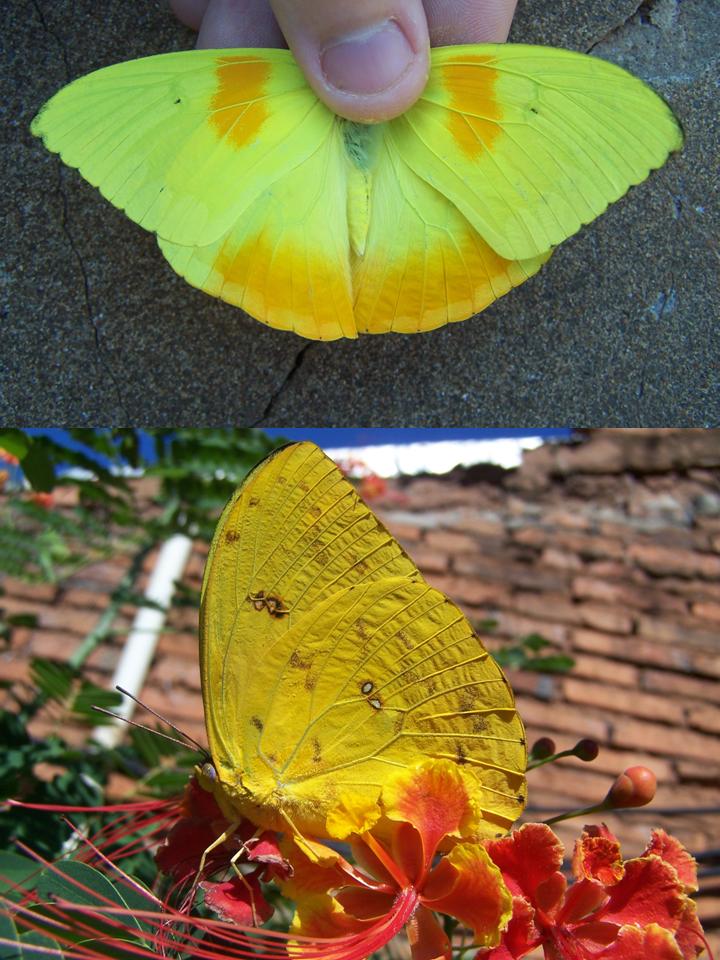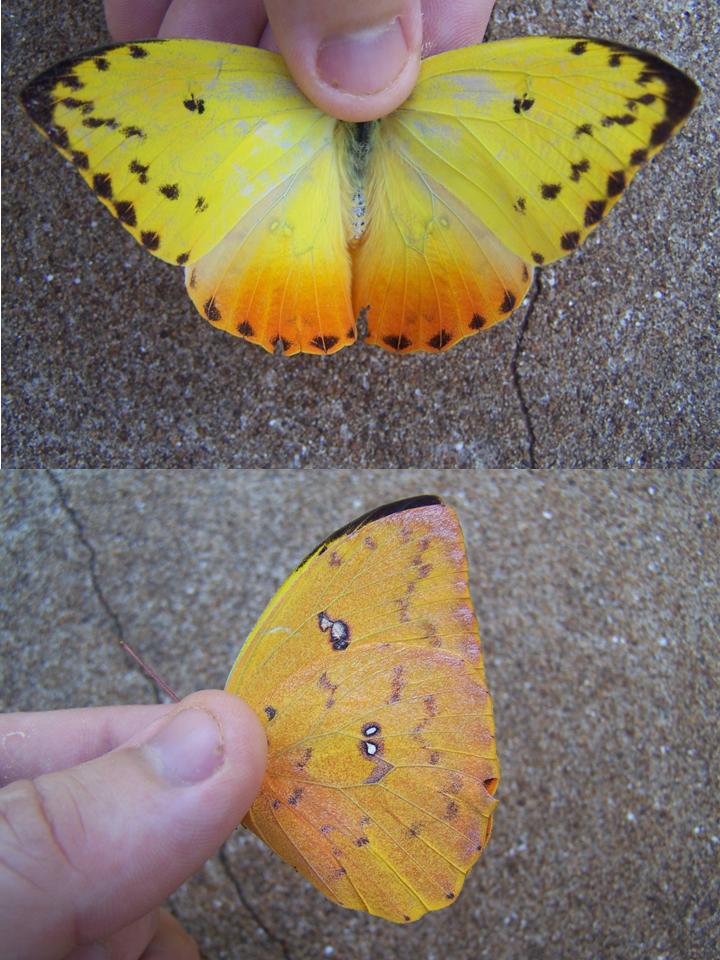

Designed by Paul Smith 2006. This website is copyrighted by law. Material contained herewith may not be used without the prior written permission of FAUNA Paraguay. Photographs on this web-site were taken by Paul Smith, Hemme Batjes, Regis Nossent,
Alberto Esquivel, Arne Lesterhuis, José Luis Cartes, Rebecca Zarza and Hugo del Castillo and are used with their permission.
Phoebis philea philea (Linnaeus 1763)
ENG: Orange-barred Sulphur
ESP: Azufre Gigante, Mañanita
JIZ: Forewings square. Folded wing triangular, with steeply rounded costa, right-angled apex and straight outer margin smoothly rounded at anal angle. Sexually dimorphic. Poses with folded wings. FLI: Fluttery but powerful and straight.
UPP: M (Fig 1) Lemon-yellow with two broad, orange, vertical postbasal bands on the forewing and broad orange submarginal band across hindwing. Single tiny black median spot on forewing and 6 very indistinct black spots bordering outer margin of forewing. F (Fig 2)Handsome, forewing yellow (deeper than male) with broad black apical edge breaking into 5-6 conspicuous black spots along outer margin of forewing. A slightly wavy line of 6 smudgy black postmedian spots run almost parallel to outer margin and makes an angle with three smaller black spots bordering the outer half of the costa. Single small but conspicuous smudgy black median spot on forewing. Hindwing similarly yellow with fiery reddish-orange submarginal blush on outer half and line of 4-5 conspicuous black spots bordering outer margin.
UND: M (Fig 1) More mustard yellow with double black-edged brown medial spot on forewing and brown-edged white medial spot on hindwing. Scattered and sparse brown spotting across entire underwing is indistinct and less prominent than in Phoebis argante. F (Fig 2) Deep mustard with pronounced rosy bloom strongest towards the base of the hindwing. Conspicuous double black-edged white medial spots on both wings, those on the forewing joined to form a vague hourglass shape and those on hindwing separated. Scattered pinkish-brown wavy lines on underwing postmedial section of both wings. Apex and submarginal edge of forewing blotched pinkish-white.
BOD: Head and thorax mustard-yellow ventrally. Head brown above. Thorax black with lemon-yellow hairs. Abdomen lemon-yellow, with thin three-quarter length medial line on upperside. Antennae red-brown, slightly darker on dorsal side of clubs and pale brown on underside of club. Eyes bicoloured, mustard on lower half brown on upper. Legs pale yellow.
MMT: A large Sulphur. CL - 43.1mm (40-46mm); BL - 29.2mm (27-31mm); WS - 90.3mm (85-95.5mm); HW - 4.6mm (4.5-5mm); AL - 16.2mm (15-17mm); n=13 (2M 3F).
SSP: Recognisable by size alone, it is much the largest of the Sulphurs. Underwing pattern of male recalls large Phoebis argante but note more pronounced double median underwing spot, more smoothly-rounded costa and less pointed apex. Females with diagnostic roseblush bloom to underwing are unmistakeable but probably closest to female Phoebis sennae. That species is much smaller and lacks any pinkish or orange colouration. Female sennae is the only species to share the paired white median spots on the underside of both the hindwing and the forewing. Male is the only Sulphur with broad orange bands on the upperwing.
ABU: Uncommon, generally less common than other Coliadinids and rather less social, more often encountered alone.
HOS: Plants in the family Fabaceae including Senna (Canals 2003).
Citable Reference: Smith P (2007) FAUNA Paraguay Online Handbook of Paraguayan Fauna Butterfly Species Account 4 Phoebis philea.
Last Updated: 3 September 2007.
References:
Canals G 2003 Mariposas de Misiones - LOLA, Buenos Aires.
 | FIGURE 1 |
|
 | FIGURE 2 |
|
FIGURES 1 - Encarnación, Departamento Itapúa (Paul Smith 5 May 07); 2 - Encarnación, Departamento Itapúa (Paul Smith 5 May 07);

